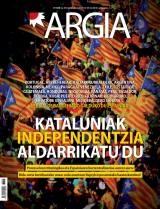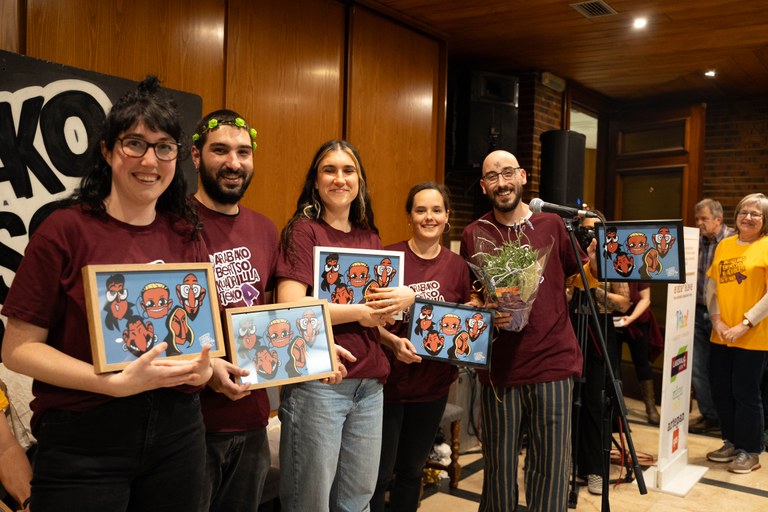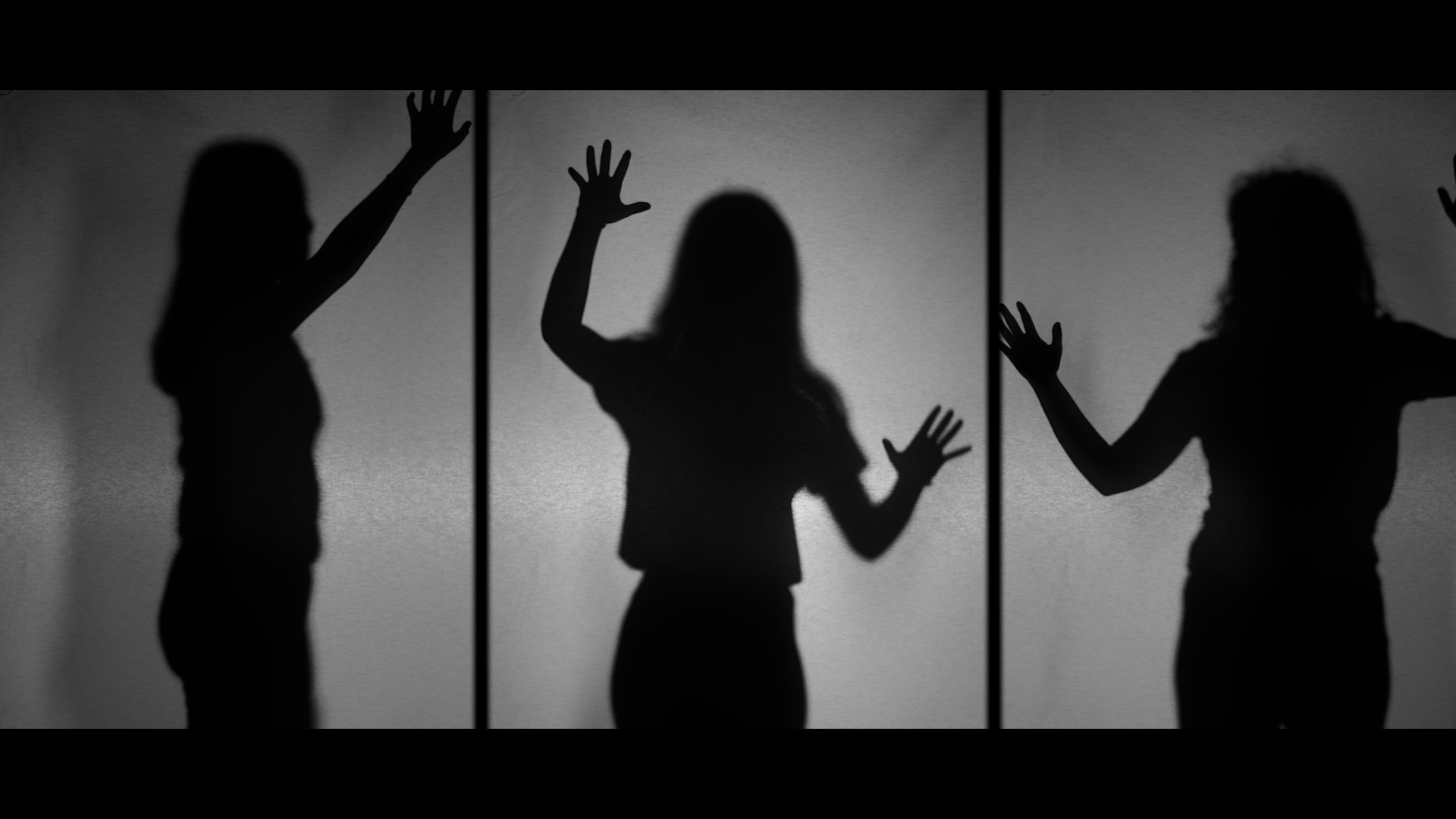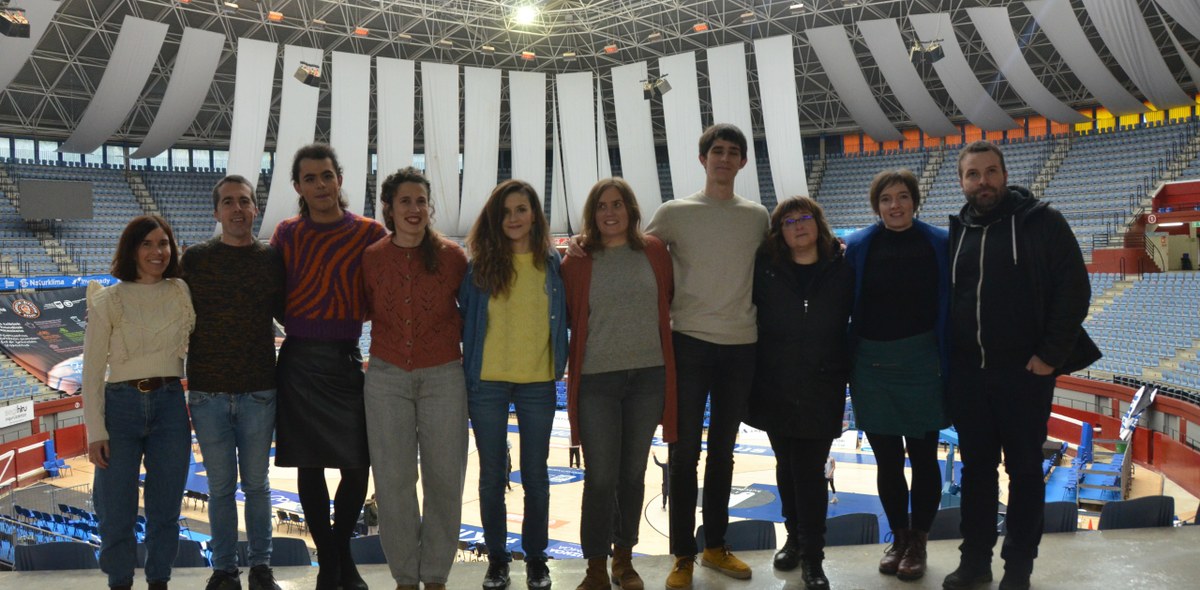"If bertsolari manages to adapt the melody to words, he gets a double surprise."
- Do you remember that special singing from the bertsolaris of the old recordings? What has changed so much in two generations? Itziar Navarro has given several answers in the study The cantinera of the bertsolaris of Oiartzun since the middle of the twentieth century. This work, which already received the Laboa grant from the Mintzola Foundation last year, joins its two hobbies: He started at the Gaztetxe Kortxoenea singing bertsos every week in the group. For a while he was “intermittent” to the bertsolaris schools of Egia and Añorga. He writes many verses. Meanwhile, after studying guitar and master's in Cultural Musicology in Götingen (Germany), he spent seven months in Greece in the Traditional Music department of TEI Epantivirus.
Itziar Navarro defines singing as: “How to manage sounds and time when singing, how to adapt the melody suddenly.” The song has a very important function in the bertsos: “Give more expressiveness to words.” Therefore, what Navarro proposes is not to train the bertsolaris as singers, but to “be able to take advantage more by being aware of the resources of the song, moving away from the song of four”.
The study indicates eight parameters that characterize singing: rhythm, tempo, dynamics, articulation, ornaments, intonation, timbre and accentuation. In his work he analyzed how to take advantage of these eight aspects that make up the song each of the six bertsolaris of Oiartzun of each time (you have them on page 44). And it explains to us that evolution is remarkable: older people used a lot of ornaments, even bigrates, and they projected the voice with less accustomed bells today. The use of the microphone has made many of these resources lose meaning, but there are more changes in the way of life that have changed the way of singing. However, he stressed that among the bertsolaris there is a wide variety of songs: “Unai Agirre listens to some ornaments, Jexux Mari Irazu as well – that’s a matter of taste. What you've heard, what you like and what you still use. Vibrata is used by Maialen Arzallus and Aimar Karrika, for example.”
Ears adapted to the organ of the church
"Untense intonation is still used in Ipar Euskal Herria, but in Hegoalde we have been made almost all of our ears at temperature"
There are ways of intonation, out of the piano keys. What we know in piano keys is called “laying intonation”: “Within the Western European system there are shades and semitonos. But that's what was built, took the octave and spread over the same intervals, because that's how the music became transportable: we can play in do, then in re -- we could play with the same piano in all tones. That has its price: when you make intermediate noises with the voice, it clashes with the temperature.” After Bach the tension of intonation spread: “Also imposing; the church has had a tensioning function, voluntary or involuntary, if you’re talking to the organ every week... Capella sung and with popular music can maintain untense intonation. Then, radio has brought us tension on a massive scale.” Navarro reminded us that globalisation works through channels: “We have not had the singing of Senegal, nor the singing of Indonesia. We have come to the USA, France...”. In Ipar Euskal Herria, untended intonation is still used, but in Hegoalde almost all our ears have been made: “If you now make an intermediate sound, maybe it’s a challenge, it’s not that you have that system in your ear and reproduce it, who has listened to these intonation intervals intensively? Maybe if you've learned some melody, some recording of Xalbador, you've got somewhere left. But in general, we don't listen or internalize those sounds."
What life, what do I sing?
“Many generations who learned to sing in the church lost that weekly space and at home is not so much sung. In other times they also sang in working meetings.” Navarro tells us that the change of society has changed the way of understanding music: “Before it was something you made music, and you didn’t put anything. And you work the song singing, not listening. The number of songs you know isn't the number of songs you've heard that you can tarry more or less or that you're known. Knowing the melody means you're able to sing. Knowledge comes from experience.” Today we have other spaces to sing: music school, choir, bertso eskola... “If you go to them and sing a lot, you will work. But in general there has been a setback of the song, as Joanito Dorronsoro also says. The more you work, the more you know your voice, the more resources you develop.”
We have seen how mediation (radii, CDs...) influenced our ear to educate the temperature of intonation. But it produced many more things. “Mediation, especially radio, has brought us a lot of sounds that we hadn’t heard before, listening to those recorded sounds, and I don’t know if we are aware that recorded sounds are treated: songs are artificially recorded at a rate pushed to a regularity, voices go through different filters, they are treated so they don’t defy -- so, when you hear the recordings, you’re imitating, unintentionally, something that is not real. The most serious part of mediation is that we are not aware that it is in the middle.”
“In the first place they listened to a melody, and each one tried to reproduce it at home, and of course, they varied greatly. Now, learning from recording, every melody is at once and varies less."
He tells us that the process of learning melodies has a great influence on the outcome: “In the first place they listened to a melody, and each one tried to reproduce it at home, and of course, they varied greatly. Now, learning from recording, every melody is at once and varies less. Perhaps it is also a security issue, the one that has to improvise in verse can feel ‘at least if I keep the melody...’. It takes skill to play with the melody all of a sudden. From the lexicon, for example, it always sings in the same tones, but how it dominates those few melodies! He will never sing badly in those songs and change terribly, play with time.”
New songs or old melodies always new?
Navarro asks a question: “Perhaps a focus has been put on trying to bring out new melodies and there is a tendency to bring out a new melody for the championship. The key may be to focus on a few melodies so that bertsolari can see how far it can go in those melodies. But I don't know the public
"There's a tendency to bring out a new tune for the championship. The key may be to focus on a few melodies so bertsolari can see how far he can go on those songs."
The effort you will appreciate, because today the demand for melody is very high. If we don’t change often, we get bored hearing the same sound.” In the words of some experts, a singer has to sing for years to bring the melody to life and incorporate the characteristics of orality: “If bertsolari takes a melody and at the age of three he has become tired of the melody, or if he has gone out of fashion, I don’t know to what extent he has been able to cure it. For example, if you manage to give strength with a variation of the melody to say a few concrete words, you win: because the two surprises go together, the verbal and the variant of the melody.” He has set as an example Arkaitz Oiartzabal “Xamoa”, one of those studied by him, and that as it is today, he has the capacity to do so.
When the music and the melody of words go together
“We should do a prosody study with linguists,” adds Navarro: “I mean, we should look at the musicality of speech. Although Euskera has no accent, if Euskera has a flexible, mobile accent of the language chain
"Maybe the verses that give us very well in the ear get the melody and the accents of the phrases to come on par."
As we say inside, we accentuate one thing or another. It seems to me that, in a specific tone, the order of words is better in a way than in another order, together with the accents. Maybe the verses that give us very good hearing get the melody and the accents of the phrases to come on par. If the bertsolaris manage to become their own, by instinct or by force, it is amazing.” To do this, it may be appropriate to repeat with few and frequent notes: “When you have a very busy melody, you may be better off using words. And when the melody is new, bertsolari is taking care of the syllable metric, and maybe the selection of words as sound won’t work as well.”
Best school for singing
"I don't think the solution is to go to singing school. Experimentation is the way"
We asked Navarro how bertsolaris can work the singing ability: “I don’t think going to singing school is the solution. The road is experimentation, as in the bertso eskola you work other things, put singing on the table; and the bertsolaris work a lot at home, you also have to reflect on that: How do I work at home? Do I sing or write? My advice is to sing, to sing as much as possible, and since it has been sung.”
The sound is in the listener
If singing is a whole world, what we hear is a whole world. “Listening on the radio, on television or live on the bertsos program is very different. As we go through the media, we don't hear all of its ends, we don't hear all of the voice's presence. The direct always gives more information. And also in the bertsos session, the voice we receive with the microphone has already changed. And depending on where you're sitting, your perception changes as well... Personal perception always depends on many variables and is very personal, listening from the beginning is selective. Therefore, investigating how the listeners perceive it, what they like and why they like each of the topics would be very nice.”
Navarro's eyes are curious when he talks about the connections between the bertso and the sound: “I would study how it is sung in each type of performance, as the same is not done in a festival or in a competition. I want to interview the bertsolaris of Oiartzun who I've analyzed as soon as possible, to see if they consciously adapt their song. You can also analyze the way they use accordion, how they learn melodies -- the singing of some bertsolaris from the perspective of intonation: Xalbador, Uztapide, Lasarte, Enbeita”.
SONGS ANALYZED AND TWO BRUSHES OF EACH ONE

"Kantari ona. Two of its features are projection and presence; besides being big, it also opened a lot of mouth to sing... and projected its voice tremendously with strong vibrato. Clumps and other figures are made automatically, more than anyone else."

voice has a body, a special timbre. I usually sang quickly, and in many recordings it was noticeable that I didn't have the throat well."
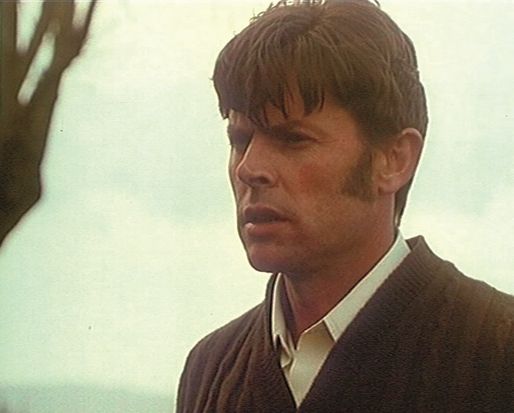
noted that he listened to the singers of that time. Sings much more round, slower and elegant, adopts the aesthetic of the singers. At least in the corpus I've analyzed, it's Koxme Lizaso, who sings alongside Alaia Martin, at the poles."

he has a mode of singing similar to the old, but by the microphone or, at least, without projecting so much. Your voice is softer. It has a style that fits everything, for the bar, for the championship and for the festivals."

“Bizi kantatzen da, azkar. He hardly uses ornaments, but he plays with the melody, he makes variants... explained by the being of the bertsolaris family".

with the doorbell. It lowers the sonority as it says, it changes the color of the voice... It's interrupted between words, it's rested, it wins in expressiveness. They are distinguished by these two characteristics."
Maiatzaren 8an hasiko da Bizkaiko Bertsolari Txapelketako sailkapen fasea. Zortzi saio bikoitz jokatuko dira maiatzeko eguenetan. Sarrerak eskuragai daude bertsosarrerak.eus atarian.
Asteburu honetan hasiko da Gaztetxeak Bertsotan egitasmo berria, Itsasun, eta zazpi kanporaketa izango ditu Euskal Herriko ondorengo hauetan: Hernanin, Mutrikun, Altsasun, Bilboko 7katun eta Gasteizen. Iragartzeko dago oraindik finala. Sariketa berezia izango da: 24 gaztez... [+]
Vagina Shadow(iko)
Group: The Mud Flowers.
The actors: Araitz Katarain, Janire Arrizabalaga and Izaro Bilbao.
Directed by: by Iraitz Lizarraga.
When: February 2nd.
In which: In the Usurbil Fire Room.
In recent years, I have made little progress. I have said it many times, I know, but just in case. Today I attended a bertsos session. “I wish you a lot.” Yes, that is why I have warned that I leave little, I assume that you are attending many cultural events, and that you... [+]







